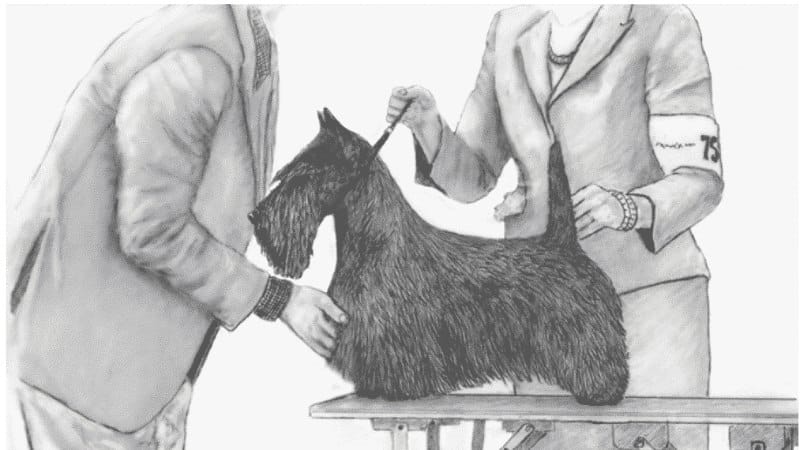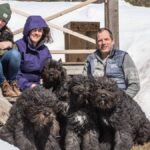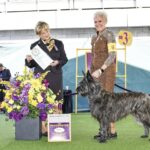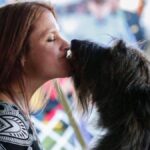Judging the Scottish Terrier
Science has been described as ever lurching after exactitude, and every time it appears within our grasp it takes another step away toward infinity. In essence, the more closely you examine something, the more you learn about it, but also the more questions emerge. Many years ago, I wrote an article to describe judging my breed. This rewrite has been informed by my own experiences and the pertinent questions of other judges, who are lifelong learners, as they engage in judging the “Diehard.” I have also attempted to add more of the “why” in addition to the “how” of judging the Scottish Terrier.
– Kathi Brown
“HIS COMMANDING PRESENCE, HIS UNFLINCHING GAZE, HIS DEEP ROOTED CONVICTION THAT HE IS HIS OWN MAN; THESE ARE THE ATTRIBUTES OF THE ADULT SCOTTISH TERRIER OF A PROPER TYPE. ONCE WITNESSED, THIS ATTITUDE IS HARD TO FORGET.”
– Evelyn Kirk 1996
The silhouette of the Scottish Terrier is one of the most recognizable in dogdom. As a judge, we go well beyond and are able to recognize, compare, and contrast specimens according to the salient features and disposition of the breed. The Scottish Terrier is in all aspects a small, sturdy dog of serious purpose that will fearlessly go to earth after badger and other prey.
Scottish Terriers should enter the ring with confidence, owning the ground they stand upon. Many are busybodies and may resist the handlers’ efforts to face in the predetermined, proper direction. Each dog should convey the belief that he is the best, regardless of your judgment. Stand back and assess each entry. Although many handlers will kneel and stack their dogs, your eye should seek a small, compact, muscular dog of good bone and substance, with a head that is long in proportion to its size. Check for a smooth flow of neck into shoulder, level topline, a pronounced forechest, and rump extending beyond the tail—the tail is NOT the end of a Scottish Terrier! Move to the front of the line looking for a varminty expression and also for the proper width of each dog.
The dog goes around the ring covering ground even with short legs, reaching out with its front feet almost to the point of its nose, and powerfully pushing with its rear, showing good extension of the rear foot. Do not misconstrue lots of quick little steps for effective reach and drive. Ears may fold back while in motion, but the tail is carried up. Recheck for a level topline while on the move.
Judges should be sure to avail themselves of two major opportunities to evaluate the Scottish Terrier; table examination and free-standing. The first is a breed-specific examination on the table, which can confirm or change your initial opinion. Skillful grooming can both enhance the dog and camouflage problems. Hands on the dog will uncover where hair is filling holes. Check the proportion and height of the dog (10″ at the withers) with your hands. The Scottie at work must be small enough to invade dens and small burrows without being trapped by his own height and bulk.
Stand back and take a minute to carefully observe expression. The ears contribute greatly to proper expression, being “set well up on the skull” forming a straight line up from the side. They are relatively small and mobile, thus you will want to check these again when on the ground and alert. I often check the ear set both from the front and behind the dog, where it cannot be hidden by grooming. The correct expression once seen is hard to miss again. The Scot will generally look down his nose at you with a penetrating gaze letting you know that he is in charge. This is described as “varminty” and should NEVER be sweet, appealing or cute.
The eye set (deep with fill under the eye), shape (almond), and color (dark) are critical components of expression. “The head should be long in proportion to the overall length and size of the dog.” The length is well-balanced. It should not be achieved by over refinement of the skull or by an unbalanced, elongated muzzle. The standard is clear that the skull is of medium width, giving the impression of narrowness due to its cleanness of skull and overall length. This skull should be clean; not cheeky or coarse, which would detract from the necessary strong, powerful bite. The bite is level or scissors with LARGE teeth capable of encountering and disposing of quarry.
 When I approach the dog on the table for hands-on examination, I generally speak to the handler, “good morning” or “good afternoon.” This is not to be a congenial person, but to elicit a response from the handler which will indicate to the dog that I am an acceptable person about to examine him. Reach out, cupping the head underneath the muzzle at the same time to determine its strength that fills a man’s hand, and for a punishing, strong underjaw.
When I approach the dog on the table for hands-on examination, I generally speak to the handler, “good morning” or “good afternoon.” This is not to be a congenial person, but to elicit a response from the handler which will indicate to the dog that I am an acceptable person about to examine him. Reach out, cupping the head underneath the muzzle at the same time to determine its strength that fills a man’s hand, and for a punishing, strong underjaw.
Check for the proper equal proportion of skull to muzzle, placing your thumb into the stop to determine if the correct “slight but definite stop” is present, rather than cut-in by grooming. Feel under the hair to determine that there is true fill below the dark, almond, wide-set eyes. Although slightly domed, the skull should appear flat and the planes, viewed from the side, parallel. While at the front of the dog, I bring my cupped open hand on the chest feeling for the required forechest and prosternum. This procedure is stated within the standard. It is important to feel for the forechest as it is often covered by careful grooming. Then drop your palm straight down between the legs to ascertain the relative straightness and width of the forelegs.
Move to the side, running your hand down the strong “moderately short” neck, across the shoulders and body to reconfirm a smooth transition into the “well laid back and moderately well knit” shoulders specified in the standard. It is important to check for an upper arm approximately the same length as the shoulder blade, bringing the elbow next to the body below the widest point of the rib and well back on the dog. Judges should feel for the chest, which is described as “broad, very deep and well let down between the forelegs.” It is a heart-shaped (not slab-sided or barrel-shaped) chest in cross section, tapering to a point and dropping down BELOW the elbow.
The standard is clear that the “lowest point of the brisket should be such that an average man’s fist would fit under it with little or no overhead clearance.” To properly examine a dog according to the standard, the judge should therefore measure width and depth by actually placing his fist under the dog. I prefer to do this measure from the side just behind the front leg at the deepest rib. If you are tall enough to do so from the front, make sure that you do not place your face in the dog’s and go back to the lowest point under the brisket.
Continue along the ribs which should be “well back into a short, strong loin, deep [in] flanks…” The inverse carrot tail is set-on high and carried proudly. Check behind the tail for the point of ischium and the broad, muscular hindquarters with a well-bent stifle allowing for the breed to spring from rock to rock as well as to pull the vermin out of its den. The length from hock to heel is short and perpendicular to the ground.
A Scot’s coat is critical to the climate of the country of origin and to the work it needs to accomplish. This is a double-coated breed with a HARD, wiry topcoat covering its dense, soft undercoat. Check the texture by rubbing the top hair between your thumb and index finger, then pick it up, looking for the requisite undercoat. The dog’s jacket should blend smoothly into its furnishings. The furnishings should never resemble a billowy skirt. The preparation and presentation of the Scottish Terrier takes skill, dedication, and time on behalf of the owner and should be carefully evaluated and respected. Never rake the jacket backward toward the head. Scottish Terriers come in coats of many colors (except white)—all are equal; none preferred. White is allowed ONLY on the chest and chin, and this to a slight extent.
The dog will most often shake himself out once again, getting comfortable before moving. Going away, the rear movement should be straight and true with good flex at the hock. The pads of the rear feet should turn up toward you. When judging front gait, the forelegs are not exactly parallel to each other; there is a slight turn in as they reach out around the deep chest of the dog. The Illustrated Guide to the Scottish Terrier states, “It is important to note that a dog that is higher in leg will appear to move better in a generic sense. This is not desirable and is at the expense of
Scottish Terrier type.” The Scottish Terrier is a “short-legged” breed. To infer that he can be too short-legged is far too simplistic. The entire harmony of parts is critical on a small dog measuring ten inches at the shoulder, yet a big dog in body. Too many are lacking the essential heart-shaped chest and the desired angulation that are essential to function and movement. From the side, the dog carries a level topline. The reach from the front and the extension and powerful drive from the rear should be evident.
The standard states clearly, “No judge should put to Winners or Best of Breed any Scottish Terrier not showing real Terrier character in the ring.” A Scottie is never timid, and one with its tail down should not be your choice. What then is true Terrier temperament? While structurally the breed is a big dog on short legs, it is a bigger dog in his mind as well; self-confident, sturdy on the ground which is “all his,” and more than willing and capable of dispatching vermin in its den.
This is displayed by the carriage of his tail, head and ears. It is helpful that you as a judge view the dog standing on his own rather than being poked and prodded into a predetermined stance. Sparring is useful to have the Scottish Terrier show himself. Judges should use the spar judiciously. You need not spar every dog. When pulling dogs to be sparred, make sure you set specific guidelines to be followed. Dogs already exhibiting feisty behavior may not be necessary to engage with others. I generally spar two dogs under consideration and am thoughtful regarding those I need to see. It is not necessary to have the dogs cause a ruckus (although this may occur), but only to collect themselves and stand boldly, four-square.
I would offer all judges a few suggestions:
- Always move the Scottish Terrier prior to table examination. This is a breed that in temperament needs to “get the kinks out” and assess the ring on his terms.
- Never reach down and examine the dog while on “his” ground; if you need to check the dog, request it to be re-tabled.
- Remember this breed is dignified, self-confident yet sensitive, and they do not easily tolerate intimacy from strangers. So do NOT baby-talk, grab and hold his beard, pound on him or become nose-to-nose with him.
- Provide shade on hot days for this generally dark, double-coated breed.
- Control the ring, separating overly feisty dogs, and control the spar.
The Illustrated Guide to the Scottish Terrier may be obtained from the Secretary of the STCA and contains a single-page quick check of the key elements of the breed for your judge’s book.
Read Lovely Fire by Mrs. Evelyn Kirk as printed in the September 1977 AKC Gazette.




 When I approach the dog on the table for hands-on examination, I generally speak to the handler, “good morning” or “good afternoon.” This is not to be a congenial person, but to elicit a response from the handler which will indicate to the dog that I am an acceptable person about to examine him. Reach out, cupping the head underneath the muzzle at the same time to determine its strength that fills a man’s hand, and for a punishing, strong underjaw.
When I approach the dog on the table for hands-on examination, I generally speak to the handler, “good morning” or “good afternoon.” This is not to be a congenial person, but to elicit a response from the handler which will indicate to the dog that I am an acceptable person about to examine him. Reach out, cupping the head underneath the muzzle at the same time to determine its strength that fills a man’s hand, and for a punishing, strong underjaw.





